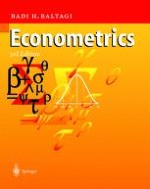2002 | OriginalPaper | Buchkapitel
Simple Linear Regression
verfasst von : Professor Badi H. Baltagi
Erschienen in: Econometrics
Verlag: Springer Berlin Heidelberg
Enthalten in: Professional Book Archive
Aktivieren Sie unsere intelligente Suche, um passende Fachinhalte oder Patente zu finden.
Wählen Sie Textabschnitte aus um mit Künstlicher Intelligenz passenden Patente zu finden. powered by
Markieren Sie Textabschnitte, um KI-gestützt weitere passende Inhalte zu finden. powered by
In this chapter, we study extensively the estimation of a linear relationship between two variables, Y i and X i , of the form:(3.1)% MathType!MTEF!2!1!+- % feaaguart1ev2aaatCvAUfeBSjuyZL2yd9gzLbvyNv2CaerbuLwBLn % hiov2DGi1BTfMBaeXatLxBI9gBaerbd9wDYLwzYbItLDharqqtubsr % 4rNCHbGeaGqiVu0Je9sqqrpepC0xbbL8F4rqqrFfpeea0xe9Lq-Jc9 % vqaqpepm0xbba9pwe9Q8fs0-yqaqpepae9pg0FirpepeKkFr0xfr-x % fr-xb9adbaqaaeGaciGaaiaabeqaamaabaabaaGcbaGaamywamaaBa % aaleaacaWGPbaabeaakiabg2da9iabeg7aHjabgUcaRiabek7aIjaa % dIfadaWgaaWcbaGaamyAaaqabaGccqGHRaWkcaWG1bWaaSbaaSqaai % aadMgaaeqaaOGaaGjbVlaadMgacqGH9aqpcaaIXaGaaiilaiaaikda % caGGSaGaeSOjGSKaaiilaiaad6gaaaa!4B3A!$${Y_i} = \alpha + \beta {X_i} + {u_i}\;i = 1,2, \ldots ,n$$ where Y i denotes the i-th observation on the dependent variable Y which could be consumption, investment or output, and Xi denotes the i-th observation on the independent variable X which could be disposable income, the interest rate or an input. These observations could be collected on firms or households at a given point in time, in which case we call the data a cross-section. Alternatively, these observations may be collected over time for a specific industry or country in which case we call the data a time-series. n is the number of observations, which could be the number of firms or households in a cross-section, or the number of years if the observations are collected annually. α and β are the intercept and slope of this simple linear relationship between Y and X. They are assumed to be unknown parameters to be estimated from the data. A plot of the data, i.e., Y versus X would be very illustrative showing what type of relationship exists empirically between these two variables. For example, if Y is consumption and X is disposable income then we would expect a positive relationship between these variables and the data may look like Figure 3.1 when plotted for a random sample of households. If α and β were known, one could draw the straight line (α + βX ) as shown in Figure 3.1. It is clear that not all the observations (X i , Y i ) lie on the straight line (α + βX). In fact, equation (3.1) states that the difference between each Y i and the corresponding (α + βXi) is due to a random error u i .
